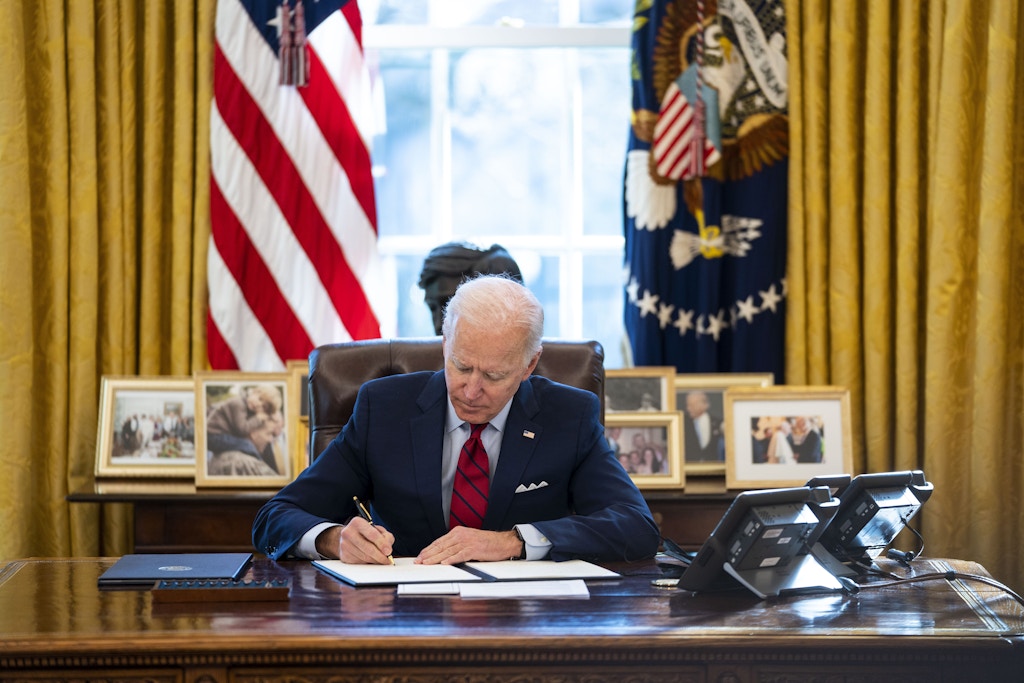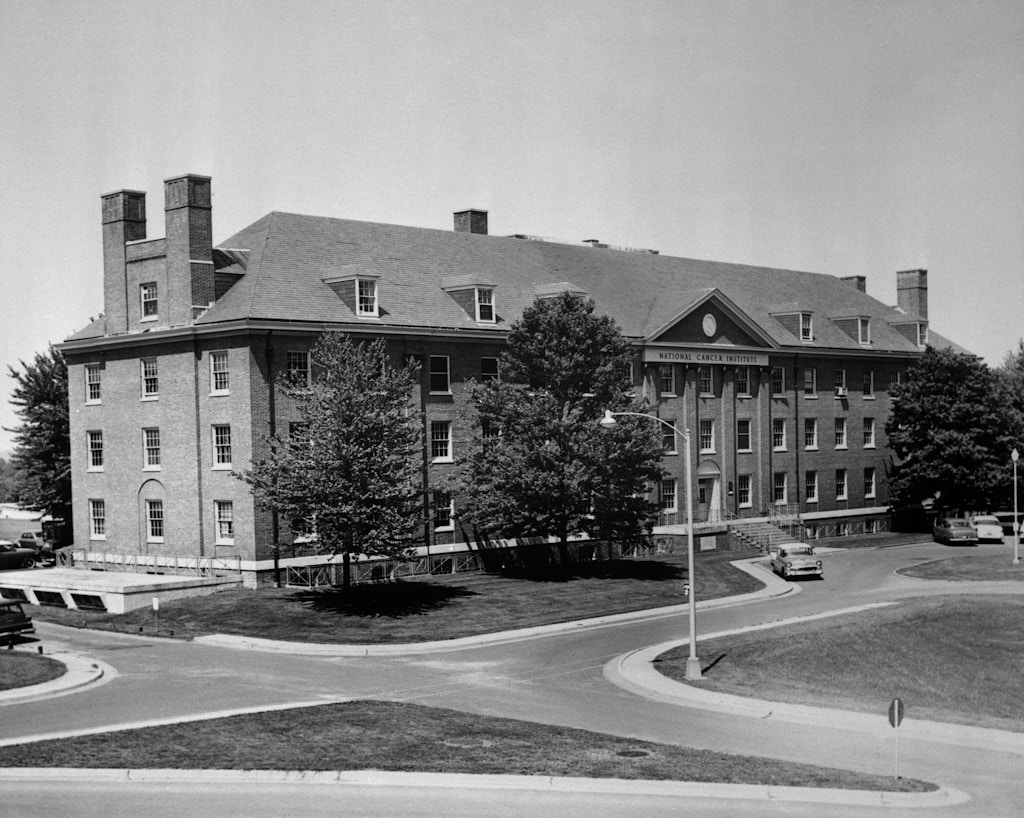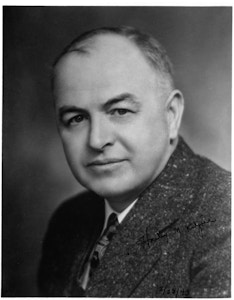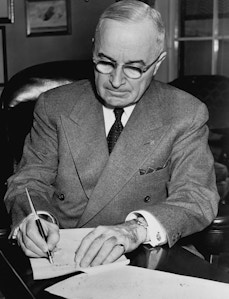1979: Inventing Competitiveness
On the morning of June 6, 1979, Navy Adm. Hyman G. Rickover, the longest-serving officer in the history of the U.S. armed services, sat down before a Senate subcommittee on the Constitution. Famous as the father of the nuclear submarine program, Rickover had recently emerged as that rarest of Washington breeds: a top-brass crusader against waste and corruption in defense contracting. On this day, he deployed his reputation and characteristic bluntness to stop a bill called the University and Small Business Patent Procedures Act.
At stake was the government’s long-standing proprietorship of patents on inventions resulting from the research it underwrote. The proposed legislation would hand patents over to the private contractors that conducted research at government expense, essentially gutting the government’s ownership stake and paving the way for monopolization. The bill’s supporters — those in favor of removing this block — included drug companies, venture capital firms, university patent offices, and the nascent biotech industry. Those opposed to this sweeping change in federal patent policy were led by a fading Democratic coalition committed to New Deal ideas about antitrust regulation, patents, and public science controlled in the public interest. Rickover was a lone but strong military voice for this coalition: a war hero with the authority of having overseen the construction of the first nuclear propulsion systems, one of the most complex government science programs since the Manhattan Project.
Speaking before the subcommittee, Rickover railed against the proposed policy changes. “Government contractors should not be given title to inventions developed at government expense,” he said. “These inventions are paid for by the public and therefore should be available for any citizen to use or not as he sees fit.”
This seemed self-evident to Rickover. After all, he noted, “companies generally claim title to the inventions of their employees on the basis that the company pays their wages.” It befuddled and angered him that the U.S. government would consider giving up its own shop rights to industries that would never do the same. In his decades managing the development of nuclear reactors, Rickover had witnessed the very contest between public interest and private greed so clearly anticipated by mid-century advocates for keeping public science under public control.
In the final months of the Carter administration, this position, advocated most forcefully during the wartime birth of today’s federal research establishment, was fading as a Democratic faith.
Since 1963, the contest to control government patent policy had centered on an executive order issued by President John F. Kennedy one month before his assassination. The order ended what had been a confusing, ad hoc approach toward patents underwritten with public money by directing agency chiefs to maintain a default policy of government patent ownership — especially on inventions related to public health.
If contractors could muster a strong case that they required the patent to bring an invention to market, the Kennedy policy allowed some wiggle room. But as a general rule, it disciplined federal agencies to be stingy in granting private monopolies on public science. And the stingiest agency of them all — to the postwar pharmaceutical industry’s displeasure — was the Department of Health, Education and Welfare, or HEW. (In 1979, it was split up into the Department of Education and the Department of Health and Human Services). For 16 years, the drug and patent lobbies had backed Republican bills to overturn the Kennedy policy. Not one had ever come close to passing.
In the summer of 1979, the latest such bill was entering its sixth month of hearings on the merits of pulling the Kennedy policy inside-out. Sponsored by Sen. Bob Dole, R-Kan., and Sen. Birch Bayh, D-Ind., it would shift the burden onto government to prove that its ownership of a patent better served the public than a private monopoly, rather than the other way around. The bill was considered a long shot to get past the dens of liberal lions in the Senate and President Jimmy Carter, but it was gaining traction among Democrats.
As the bill’s chances of passage grew, Rickover stepped up his warnings to lawmakers not to fall for “the age-old arguments of the patent lobby” and pass legislation that “promotes greater concentration of economic power [and] impedes the development and dissemination of technology.”
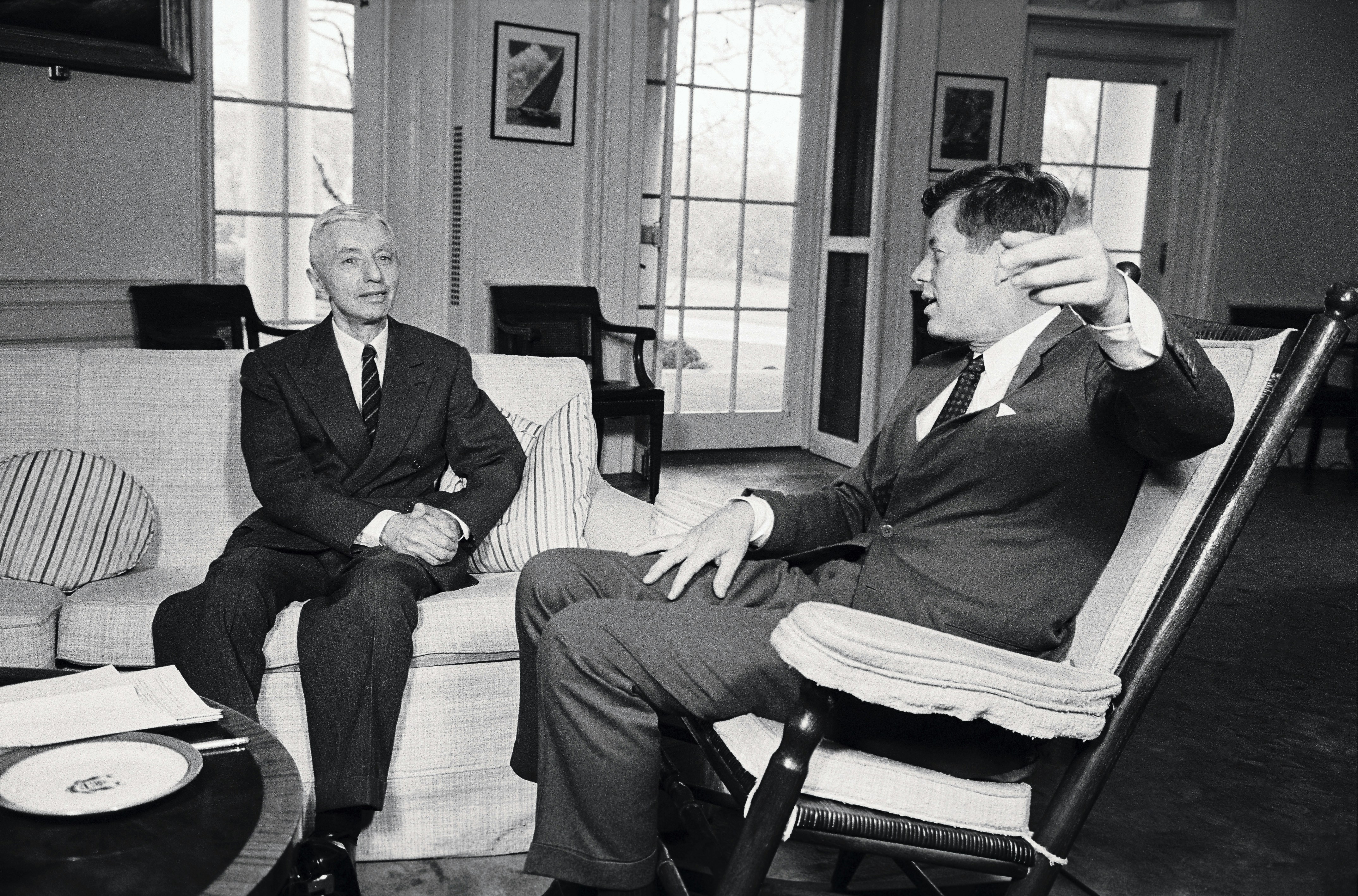
Then-Vice Adm. Hyman G. Rickover, left, director of the Navy’s reactor program, meets with President John F. Kennedy at the White House on Feb. 11, 1963.
Photo: Bettmann / Contributor
Beginning in the early 1970s, the enemies of government patent ownership embraced a trendy new phrase in the nation’s political and economic lexicons: “global competitiveness.” To compete against Europe and Asia, the argument went, Washington had to incentivize innovation by relinquishing control of inventions made under government contract and hand them over to the private sector to handle them as they saw fit.
The argument was always a scrambled one. To start, it rested on the falsehood that government inventions were being purposefully withheld from industry, when public science was, by definition, readily available for licensing and use. During the contentious hearings held on one of the failed bills that preceded the Bayh-Dole Act, Michael Pertschuk, Federal Trade Commission chair under President Richard Nixon, testified that there was “no factual basis” for claims that government ownership of patents was slowing or obstructing commercialization. He told a room of red-faced Republican lawmakers, “The available evidence shows just the opposite.”
The argument related to so-called global competition also dissolved under scrutiny. “The most formidable new rival to U.S. technological leadership at the time, Japan, maintained a much weaker patent system, and among other things required wide licensing of patents,” F.M. Scherer, the FTC’s chief economist between 1974 and 1976, told The Intercept. Meanwhile, the key technologies behind the rising Silicon Valley-based high-tech industry of the era — integrated circuits, computers, lasers, fiber optics — had been diffused not by private monopolies but by a 1954 Justice Department consent decree that crow-barred open Bell Labs’ vault of federally funded patents. According to the best available evidence, it was the private sector that hoarded patents, slowed development, and hurt national “competitiveness” — not the government.
But the anxiety of the ’70s was real, and the patent lobby held a keen appreciation for its uses in overcoming deep political and public suspicions of monopolies and the drug companies. The March 1973 issue of Newsweek introduced Americans to a British term, “stagflation,” to describe the double whammy of high inflation and unemployment. By 1975, the country was in the first full-blown recession in recent memory. It was during this time, just before Carter’s election, that a former patent lawyer-turned-assistant secretary of commerce named Howard Forman came up with an idea to drive a stake through Kennedy’s 1963 executive order. As neoconservatives outside government planned their full-court press against the Soviet Union, old-line conservatives inside government hatched a plan to destroy, at long last, the New Deal vision of public science under public control.
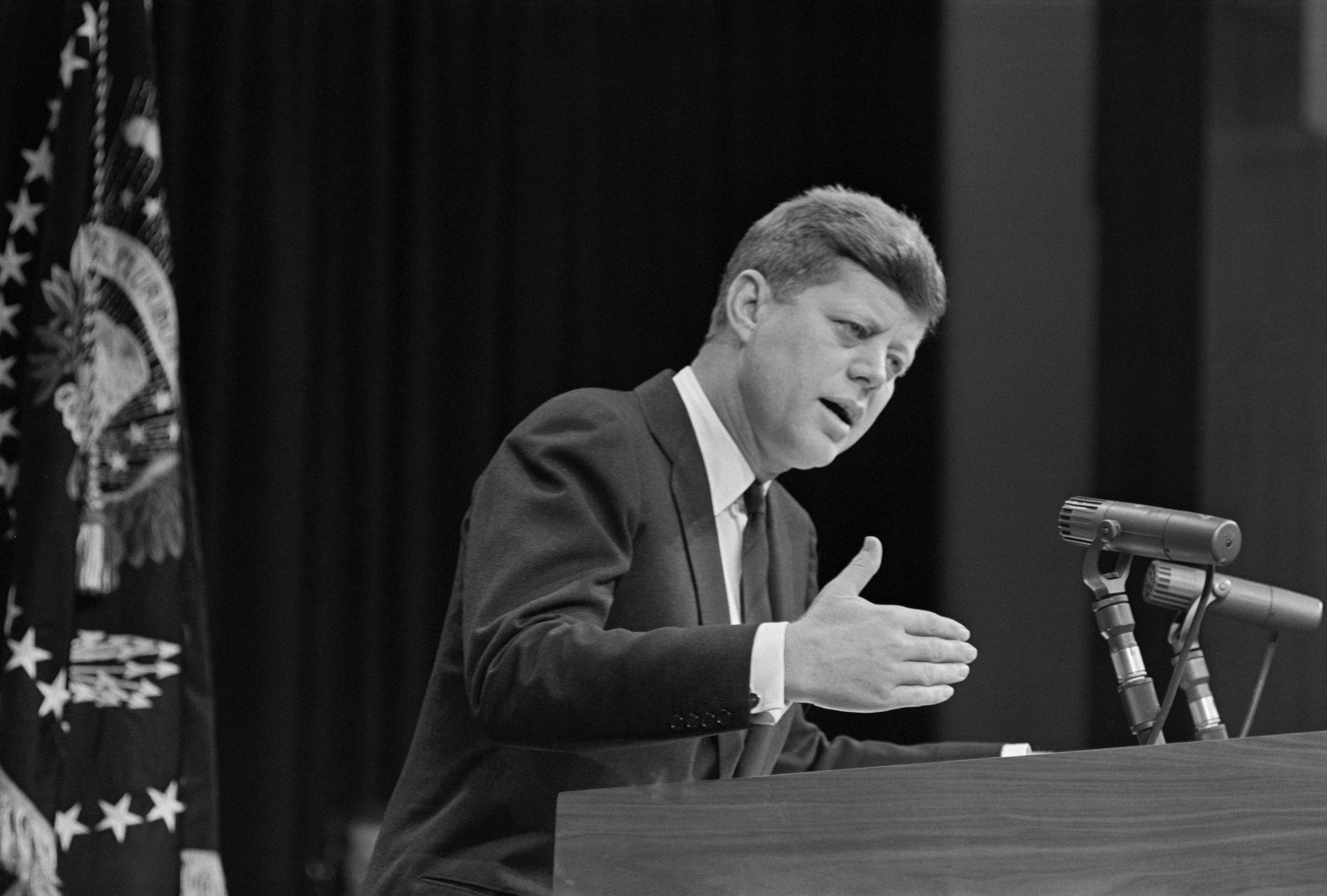
President John F. Kennedy gives a televised address in which he accuses the Eisenhower administration of allowing a “missile gap” between the United States and the Soviet Union on Feb. 8, 1961.
Photo: Bettmann Archive/Getty Images
In 1976, Forman, a lifelong Republican, referenced Kennedy’s famous Cold War claim of an emerging “missile gap” between the United States and the Soviet Union. In Forman’s view, Democrats now invited an “inventions gap” to undermine the country’s public health and economic “competitiveness.”
Speaking before the House Committee on Science and Technology in September 1976, Forman made the sensational claim that 28,000 patents were languishing unused on the dusty shelves of government agencies. (In his written statement, the number was 26,000). Each of these patents, Forman argued, represented another piece of potential progress lost to dogmatic statism. By refusing contractors the right to claim them as their own, the government was actively suppressing their diffusion and development and thus failing its constitutional mandate to “promote the progress of Science and the Useful Arts.”
“Only about 5 percent of those 28,000 patents have been the subject of some kind of licensing action,” Forman testified. “The greater majority of those patents are not getting into use, and they are doing no good to anyone.”
This notion struck a chord with many Democrats and drew positive attention in the press. Three years later, Forman’s “inventions gap” reappeared early in Bayh’s Senate speech introducing his patent reform bill for debate.
As with “competitiveness,” the power of the alleged “gap” relied on lawmakers’ shallow understanding of how patents work.
As with “competitiveness,” the power of the alleged “gap” relied on lawmakers’ shallow understanding of how patents work. The great majority of inventions, patented or not, interest no one and are never licensed. The U.S. Patent Office issues thousands of patents every day; only a tiny fraction of those are ever applied or developed into new products. Even accounting for this number was difficult, because the purpose of government research is diffusion, not legal action in defense of patent infringement. Rickover was especially irked by this sleight of hand, telling senators in 1979, “It is almost impossible to tell the extent to which government-owned patents are being used, because the government, unlike private parties, does not have reason to search for infringement [and] generally has no desire to prevent others from using its inventions.”
What data existed only undermined the case for making private monopolies of publicly funded science. From 1968 to 1978, HEW licensed a full quarter of roughly 350 patents emerging from federal research. Meanwhile, the universities and firms that were allowed to claim patents on federal research — that is, those that were granted exceptions to the Kennedy policy during the same period — licensed their patent monopolies at less than half the government rate, producing a total of four commercial products.
But the alliance behind Bayh-Dole pushed on with these arguments, backed by the university patent industry and a raft of trade associations, including the National Patent Council, the Chamber of Commerce, and the National Association of Manufacturers. The bill’s biggest beneficiaries — the drug companies — were careful to keep a low lobbying profile.
Following Carter’s election in 1976, Forman began to coordinate strategy with a rogue group of bureaucrats inside the Department of Commerce and HEW that called themselves the Government Patent Policy Committee. They were united by ideology and a loathing of Carter’s HEW secretary, Joseph Califano, a liberal Democrat who helped President Lyndon B. Johnson steer the passage of Medicare and Medicaid. Living up to his reputation, Califano did not grant a single exception to the Kennedy policy during his first two years at HEW.
Between Carter, Califano, and the Democratic Congress, the Kennedy patent legacy seemed secure moving into the 1980 election. But the Government Patent Policy Committee was a determined and creative bunch. They struck upon a simple and brilliant idea: Rather than passing a bill that openly slipped patents to drug companies, why not write one that offered them to other actors and let the drug companies in later?
On February 9, 1979, Bayh and Dole introduced S. 414, the University and Small Business Patent Procedure Act. The bill proposed what amounted to a default policy of transferring titles on government-supported inventions to small businesses and nonprofit contractors, including universities. It left out drug companies — until the law could be expanded to include them — as a ploy to win Democratic support and provide political cover. “The perceived halos over universities lit the path to passage of the Bayh-Dole Act,” Rebecca Eisenberg wrote in a 2018 article for the academic journal Dædalus.
To further mollify skeptical Democrats, the bill included a provision granting the government “march-in” rights to break private monopolies in the event that the contractor fails to make the invention available to the public on “reasonable terms.”
The ruses worked. Even Louisiana’s Russell Long, one of the Senate’s last links to New Deal liberalism, turned on his lifelong commitment to defending public science from monopolistic industry hands. In the final days of the lame-duck session following the 1980 election, Bayh-Dole emerged intact from a Democratic-controlled Congress and was signed into law by Carter on December 12.
Exactly how the bill got through the Democratic majorities in Congress and the White House remains a mystery.
“There’s no good explanation for Sen. Long flipping his position,” said Gerald Barnett, the former director of the Research Technology Enterprise Initiative at the University of Washington, who now runs the blog Research Enterprise. “If Long thought it was wrong for the federal government to allow big companies doing federal work to retain exclusive patent rights, then how could he possibly think that allowing nonprofits to retain patent rights which they then tried to pass exclusively to big companies would be any less wrong?”
Whatever Democrats’ understanding of this, the extra step required by Bayh-Dole was short-lived. In 1983, President Ronald Reagan issued an executive order expanding Bayh-Dole to include corporations of all sizes. Having served its purpose, Bayh-Dole’s stage-prop halo was removed and tossed to the wind.
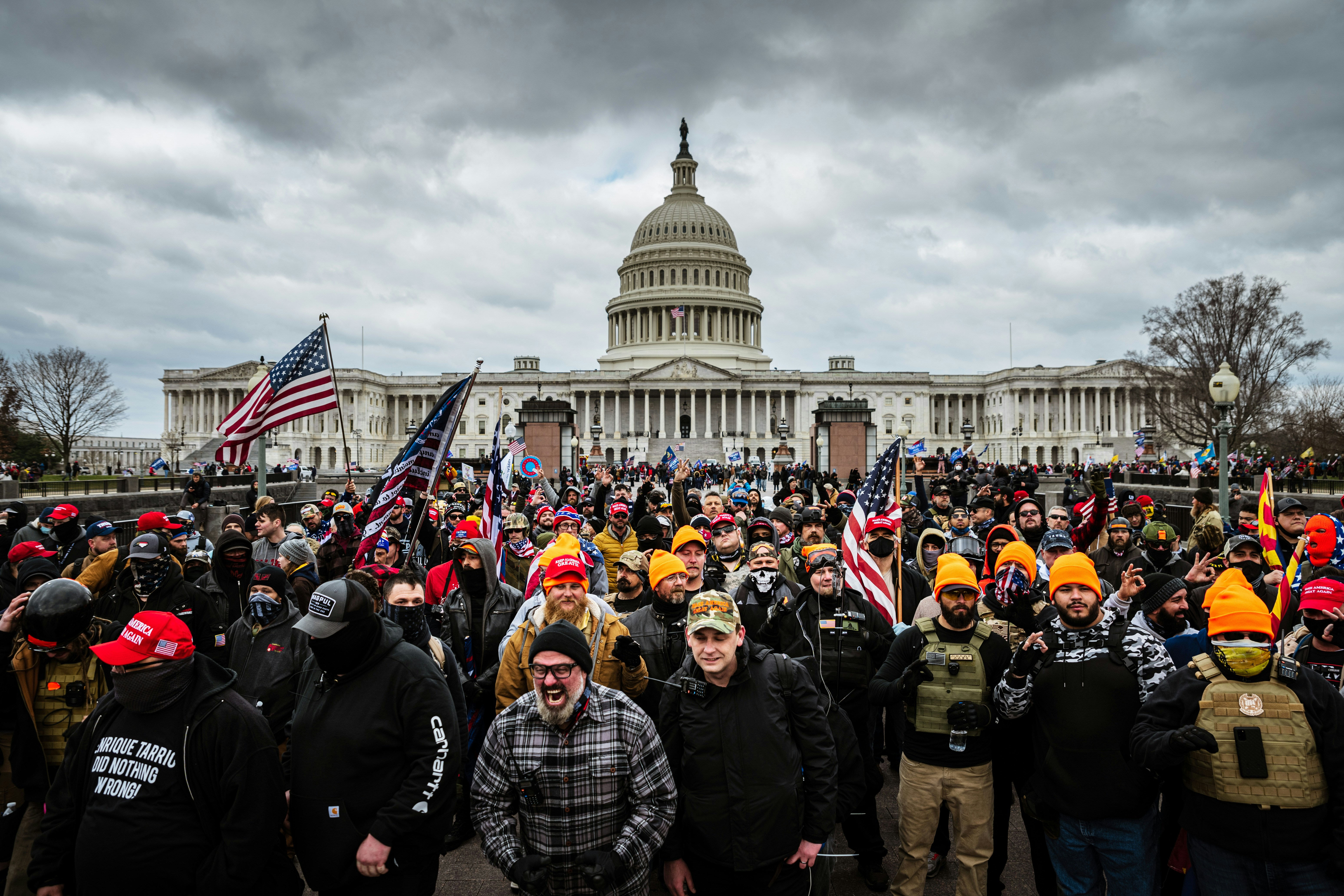
Photo: Jon Cherry/Getty Images
2021: Kicking March-In Rights
On January 4, 2021, two days before the Capitol riot, the Federal Register, the U.S. government’s daily trade paper, announced a proposal by an obscure agency called the National Institute of Standards and Technology. Nestled within the Commerce Department, NIST is not known as a political agency. But along with standardizing weights and measurements, its mandate includes advising the secretary of commerce on patent policy, putting it squarely at the center of debates over drug patents and monopoly pricing. On his way out of office, NIST Director Walter Copan, who was appointed by President Donald Trump, issued a raft of proposals to nullify the “march-in” rights that were added to Bayh-Dole in 1979 to allay Democratic concerns of price-gouging and patent-squatting. Together the rule changes represent an attempt to close the corporate circle begun by Howard Forman nearly 50 years ago.
The fuzziness of Bayh-Dole’s “reasonable terms” clause has always been a subject of intense debate. Simply put, the term sounds like it should cover “reasonable cost,” and a number of civil society groups have embraced this reading, petitioning the government to break up monopolies on federally funded research in the public interest. To date, all of these petitions have been denied, but the mere threat has on rare occasions successfully pressured companies into reducing monopoly prices.
Offering a different interpretation of Bayh-Dole’s march-in clause are the drug and biotech industries, the university patent and technology transfer lobbies, and the bill’s original sponsors, Bayh and Dole, who both went on to work for corporate law firms and lobby shops with drug industry clients. When march-in petitions-based “reasonable pricing” interpretations of the law have been granted hearings, all have insisted that march-in power was never meant as lever to reduce “unreasonable” prices.
Copan’s NIST proposals would settle the matter in industry’s favor not only by formally eliminating price as a basis for march-in, but also by banning civil society groups from the march-in administrative process altogether. If adopted, only competing firms would enjoy the right to challenge the legitimacy of a federally financed monopoly.
Like Forman and other Department of Commerce officials who devised the strategy behind the passage of Bayh-Dole, Copan spent decades working in corporate patents and tech transfer before joining the Department of Energy in 2011. As chief of technology transfer, he oversaw a program called the Agreement for Commercializing Technology that drastically restricted what the government could do with the nonexclusive licenses on its own inventions allowed under Bayh-Dole. (Essentially, the program limits the government to in-house research.) In 2017, then-Energy Secretary Rick Perry made the ACT permanent policy at the agency; Copan’s proposals and a GOP bill based on them would institute it governmentwide.
Taken together, the NIST proposals would strip Bayh-Dole of the public interest safeguards that its sponsors touted in order to pass the bill. They would result in a conveyer belt of federally subsidized monopolies shielded from the slightest threat of interruption by the public that pays for the underlying research. But the cynicism on display goes even deeper. In an April 2019 NIST green paper titled “Unleashing American Innovation,” the agency proposed edits to Bayh-Dole — a law sold on claims that the government was not commercializing its patents — that define down industry’s obligation to achieve “practical application” of federally funded inventions. The arguments being pushed to justify these changes may sound familiar: Innovation and national “competitiveness,” it seems, are once again at stake. The Republican House bill based on the paper is called the Securing American Leadership in Science and Technology Act of 2020.
As during the ’70s, the drug and biotech industries have studiously kept themselves in the background of the NIST debate. Taking a public stand and reprising their 1979 roles is a crew of familiar faces in the university patenting and technology transfer industries, led by the Wisconsin Alumni Research Foundation and AUTM (formerly the Association of University Technology Managers). Pharma and biotech are present at one remove in the form of industry-funded front groups such as the Information Technology and Innovation Foundation and a new outfit called the Bayh-Dole Coalition.
These groups dominated a virtual public hearing on the changes organized by NIST in March. Although a record number of comments were submitted opposing the reforms, participants say the event was designed to exclude critical voices. Following 20 speakers from groups supporting the changes, just one critic was allowed to speak before NIST officials abruptly ended the event. “It was farcical,” Public Citizen’s Steve Knievel told The Intercept.
Whether the NIST proposals make a further farce of the government’s duty to protect the public interest falls to the White House and Commerce Secretary Gina Raimondo, the former governor of Rhode Island and a career venture capitalist. Based on Biden’s July 9 executive order, “Promoting Competition in the American Economy,” Raimondo will not only reject the NIST changes, but she may also yet play a part in reversing the course of the humiliating 40-year public science giveaway known as Bayh-Dole.
Writing in the New York Times, economic historian Nelson Lichtenstein described the executive order and Biden’s accompanying speech as reviving “the great antimonopoly tradition that has animated social and economic reform almost since the nation’s founding.”
The executive order notes that reviving this tradition begins with a deep review of government patent policy. “Too often, patent and other laws have been misused to inhibit or delay — for years and even decades — competition from generic drugs and biosimilars, denying Americans access to lower-cost drugs,” it states. It directs Raimondo to reject the NIST attempt to reduce the government’s role to shoveling money and inventions at the private sector and then standing mute and feigning powerlessness as drug and biotech companies fleece and kill the public with monopoly prices.
If the Biden administration is to earn its self-flattering comparisons to President Franklin D. Roosevelt, it will have to move beyond defense and show a fighter’s mentality that has not been seen in a Democratic White House in a very long time. Even with march-in and “reasonable terms” language on the books, every president since Carter has allowed industry to monopolize government science on its own terms, intervening only rarely — not to protect the public, but to further clip the social contract in industry’s favor.
As it happens, Biden moved into the White House to find an opportunity for clarifying action all but wrapped, bowed, and sitting on the Oval Office desk.
After malaria and yellow fever killed more of their soldiers than bullets in the Spanish-American War, the U.S. Army and Navy spearheaded the government’s entry into infectious disease research. It has since expanded its medical purview to other maladies affecting its ranks, from PTSD to cancer. Since 1997, the Defense Department’s Prostate Cancer Research Program and the National Institutes of Health have spent tens of millions of dollars supporting research at UCLA. An early trial funded by the Pentagon showed that one of the candidate drugs to emerge, enzalutamide, showed promise in extending the life of late-stage prostate cancer patients.
The “reasonableness” of that drug’s monopoly price in the U.S. market is at the center of a march-in petition currently awaiting judgement before the Department of Defense and the NIH.
In 2005, the University of California, the enzalutamide patent holder, cut an exclusive-rights deal with a Bay Area biotech firm called Medivation. To finish trials and bring the drug to market, Medivation partnered with a Japanese firm, Astellas Pharma. In 2012, the Food and Drug Administration approved it for sale under the brand name Xtandi. Four years later, Xtandi was making Medivation-Astellas more than $2 billion a year globally. Most of these profits were generated in the U.S., where a yearlong course was priced at $130,000 — several times higher than in any other member-country of the G-7, where governments negotiate drug prices. Medicare Part D spending for Xtandi topped $900 million annually.
These numbers drew the salivating attention of the biggest multinational drug companies, but there was a problem. The U.S. government was named alongside UCLA researchers on three of the drug’s key patents, leaving the drug vulnerable to a march-in petition. Sure enough, in 2016, two medicines-access groups filed a petition with the Department of Defense and the NIH to pull Bayh-Dole’s march-in trigger and license generic competition. All of the pieces were in place: a formal petition, a clear government stake in the rights, and a flamboyant violation of “reasonable terms” that placed a huge and unnecessary cost burden on Veterans Affairs hospitals and Medicare.
“You would think the military has a strong interest in not paying more than $100,000 for a drug it paid to develop and has manufacturing costs in single digits,” says Robert Sachs, a retired lawyer and prostate cancer patient who joined the Xtandi march-in petition in 2018. “Nobody is trying to micromanage prices. Just compare the U.S. price to other developed economies, and if it’s unreasonably higher, authorize competition.”
The missing ingredient was a self-respecting government. HHS was quiet on the petition. Inside the Pentagon, no Adm. Rickover came forward to take up the cause. Only after the Army, White House, and NIH all quietly declined to back the petition did the drug majors feel secure enough to descend with buyout offers. A bidding war ended with Pfizer acquiring Medivation and the Xtandi monopoly for $14 billion.
The pricing scandal continued to simmer during the Trump administration. In July 2017, the Senate Armed Services Committee added to the National Defense Authorization Act a new standard for determining the “reasonableness” of prices on drugs emerging from military grants. That standard — the median price of the drug in the G-7 countries — was never applied.
“The July executive order forces the government to finally make a decision on Xtandi,” said James Love, director of Knowledge Ecology International, one of the groups that filed the 2016 march-in petition. “It should be a slam dunk. Biden did the right thing in stopping the NIST proposals. The question is, does he have the guts to take next step?”
The answer will open a window not only into the administration’s viscera, but also the balance of forces between a number of senior officials with ties to the pharmaceutical industry and the “antitrust dream team” of Jonathan Kanter in the Justice Department, Tim Wu on the National Economic Council, Lina Khan at the FTC, and Xavier Becerra at HHS. The executive order clearly reflects the influence of the so-called New Brandeis movement — named for former Supreme Court Justice Louis Brandeis — said to inform this group’s approach to monopoly as an economic and a political problem. If Biden’s neo-Brandeisians are looking for inspiration to translate this approach into patent policy, they’ll find it in the records and summary statements of the New Dealers who so clearly understood the dangers of allowing public science to slip from public control and become untethered from the public interest.
1947: Public Science for the Public Good
Around the time that World War II in Europe turned the Allies’ way, a domestic battle began in Washington over who would control postwar science policy and its fruits. It was understood that the wartime crash programs would continue into peacetime, forming the most expansive state research apparatus in history. Still to be resolved were the rules determining the ownership of patents resulting from billions in federal research spending.
The New Dealers believed that the patents should be retained by the government paying for the research. This was, after all, how it worked in the private sector. During nearly a decade of hearings on postwar patent policy, figures from the Democratic coalition described this policy as having multiple advantages. Informed by Justice Brandeis’s political critique of monopoly, they believed that allowing private monopolies on public science would restrict its benefits and create dangerous concentrations of economic power. The New Dealers’ leading voice was a West Virginia senator named Harley Kilgore.
The political dimension of the monopoly issue was never far from the Kilgore-Bush debate, which spilled into peacetime. A representative for the Congress of Industrial Organizations, a federation of unions, testified in 1946 that the idea of allowing private monopolies on public science “offends American democratic principles.” Horace M. Gray, an associate dean of the graduate school at the University of Illinois, told Kilgore’s committee it was “quite unthinkable that the Federal Government should tax the citizens of this country to secure funds for scientific research, on the grounds that such research promotes the general good, and then turn the results of such research over to some private corporation on an exclusive, monopoly basis. This amounts to public taxation for private privilege and violates one of the basic tenets of our democratic faith.”
Industry and its congressional allies responded with a warning that has since become familiar: If contractors are denied exclusive rights on federally funded inventions, they will refuse to collaborate with the government. This was the response of the pharmaceutical and biotech trade associations when lawmakers attempted to attach minimal social obligations to Operation Warp Speed funding for Covid-19 vaccine research and development. It is the argument now being used to advance the NIST-proposed changes to Bayh-Dole.
The New Dealers scoffed at this. Contracting firms were receiving payment for their work, which often included extremely valuable subsidized technology transfer. Under a policy of government patent ownership, contractors would have the same access to the inventions in question as everybody else. If the offering of a nonexclusive license resulted “in hesitation on the part of large industrial concerns to participate in the work … this will be all to the good, since such concerns do not need Government support,” testified the Rockefeller Institute’s Philip R. White. “Small businesses and the general public stand only to gain from a rigorous patent policy.”
In 1950, President Harry Truman signed a Republican bill enshrining the “loose” patent policy on federal research advocated by Bush and industry. The law left it to agency chiefs to decide how to handle the dispensation of patent rights. In 1963, Kennedy firmed up this policy in the direction of government control, setting the stage for the long pushback that culminated in the 1980 passage of Bayh-Dole.
The tallest-standing monument to the New Deal patent program, and still its greatest defense, is a report commissioned by the wartime attorney general and Nuremberg Judge Francis Biddle. Published and delivered to Truman in 1947, the report catalogs a number of economic, political, and social arguments in favor of keeping public science under public ownership and diffusing it as broadly as possible. The 508-page tome is ballasted with highlights from a decade of testimony delivered to Kilgore’s subcommittee on monopoly. Seventy-four years later, its recommendations read like warnings.
“Inventions financed with public funds should inure to the benefit of the public,” the attorney general advised Truman, “and should not become a purely private monopoly under which public-financed technology may be suppressed, used restrictively, or made the basis of an exaction from the public to serve private interests.”
“Scientific and technological research conducted or financed by the United States represents a vast national resource,” the report continues. “Public control will assure free and equal availability of the inventions … [and] will avoid undue concentration of economic power in the hands of a few large corporations.”
It is hopeful that the Biden administration has signaled a desire to heed this advice. In his speech at the signing of July’s executive order, the president praised FDR by name for leaning into antitrust enforcement and calling for the end of “domination by monopolies.” It is also hopeful that the drug companies seem to be taking this rhetoric seriously. But so far, it isn’t much more than rhetoric. Any applause should be held for the political courage needed to give it meaning.
This content originally appeared on The Intercept and was authored by Alexander Zaitchik.
Alexander Zaitchik | Radio Free (2021-08-29T10:00:02+00:00) How the Bayh-Dole Act Wrested Public Science From the People’s Hands. Retrieved from https://www.radiofree.org/2021/08/29/how-the-bayh-dole-act-wrested-public-science-from-the-peoples-hands/
Please log in to upload a file.
There are no updates yet.
Click the Upload button above to add an update.
